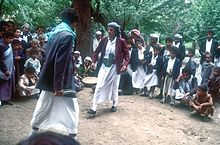Jambiya

Jambiya, or jambia (Arabic script جمبية or جنبية), is the Arabic term for dagger, but it is generally used to describe a specific type of dagger with a short curved blade that is worn on a belt. Although the term jambiya is also used in other Arab countries, it is mostly associated with people of Yemen. Men typically above the age of 14 wear it as an accessory to their clothing.
Types of jambiya

Like most other weapons, jambiyas come in brands. The price of a jambiya varies between 500 Yemeni Rials to 200 million Yemeni Rials or 1 million US dollars. The brand of a jambiya is associated with the material with which it is made as well as its quality and design.
The hilt or handle
The most significant part of a jambiya is its hilt. In fact, the price of a jambiya is in most cases determined by its hilt. The saifani handle is known to be the most famous and is found on the daggers of higher class citizens. The saifani handle is made of rhinoceros' horns, which can cost up to $1500 USD per kilogram. Different versions of saifani handles can be distinguished by their colour. Most other jambiya handles are made of different types of horns or wood. Apart from the material used for the handle, the design and detail on the handle describe its value and the status of its owner.
The blade, sheath and belt
In the majority of cases the double-sided blade of the jambiya is constructed of steel. The blade is stored in a sheath, usually made of wood. The sheath is commonly decorated with various ornaments that signify status. These include silver work, semi-precious stones and leather. The sheath is fixed on a leather belt which is normally 2-3 inches wide. The belt is usually worn around the lower abdomen. There are often other items attached to this belt, such as a silver purse for containing money and change.
Use of the jambiya
Despite the significance of the jambiya, it is still a weapon. Although people have used it in times of dispute, there are societal norms that must be followed in order to avoid defamation. The jambiya should only come out of its sheath in extreme cases of conflict. It is also commonly used in traditional events such as dances.
The Yemeni jambia


A jambia is a short dagger worn by men in Yemen. The handle of a jambiya tells the status of the man who wears it.
Structure and make
Jambias are constituted of a handle, a blade, and a sheath in which the blade is held. It is made of a certain sort of wood, to hold the blade that is fixed to the waist in a neat way. The belt that holds the jambia is made of tanned leather, or some thick cloth. There are specialized markets and handicraft markets that decorate it with golden wires.
The jambia handle often tells of the social status of the man who wears it. Some Yemenite Jews are forbidden to wear the jambia, depending on region and period, while historically the best daggers were often made by Jews. Jambias are made of African rhinoceros horn, ivory and also Almoswae horn. A kilo of this often costs $1500. The manufacturers receive this through smugglers, due to the international ban on the substance. This contributed to the retreat in the manufacturing of valuable Jambias. The rhinoceros horn is considered to be the most precious. The Jambias value increases as it acquires modern and old qualities.
Qualities of jambia in Yemen
The most famous sort of the jambia is that which has a “saifani” handle. It has a dim yellowish luster. When it is clearer, it turns into a yellow color. This is called saifani heart.
Some of the saifani handles are called “asadi”, when they turn into greenish yellow. When the handle becomes whitish yellow, it is called Zaraf. There is also an albasali (onionish), kind whose color looks like that of a white onion.
The saifani jambia is often worn by dignitary persons; among them are the Hashimites (an Arab tribe which claims a direct bloodline to Muhammad), the judges, famous merchants and businessmen. Some of these Jambias cost about Yr 70 millions, like that of sheikh Al-Shaif, which goes back to Imam Yahia Hameed Aldeen. The ordinary jambias cost about Yr 10 - 50 thousands.[1]
References
Notes
This article includes a list of references, related reading, or external links, but its sources remain unclear because it lacks inline citations. (April 2009) |
- ^ Hassan Al-Zaidi. "History of Yemeni Jambia - Yemen Times". www.yementimes.com. Retrieved 2008-06-09.
Sources
- Friedman, David and Cook, Elizabeth. "Cariadoc's Miscellany: Notes on Islamic Clothing". www.pbm.com. Retrieved 2008-06-09. 1988, 1990, 1992.
- "Ethnographic Arms & Armour - The Yemeni Jambiya". www.vikingsword.com. Retrieved 2008-06-09.
